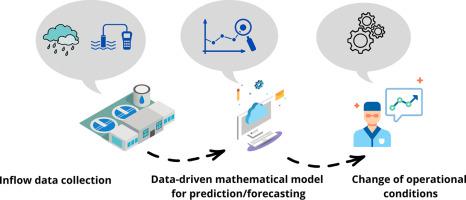Journal of Water Process Engineering ( IF 6.3 ) Pub Date : 2022-07-18 , DOI: 10.1016/j.jwpe.2022.103009 Markéta Andreides , Petr Dolejš , Jan Bartáček

|
The prediction of influent characteristics using state-of-the-art mathematical models can help optimize wastewater treatment plants (WWTP) processes. However, WWTP operators lack experience with such models and the historical data necessary for their calibration; thus mathematical models for inflow prediction are barely used in practice. On the other hand, the scientific community has recently made great strides in developing predictive modeling approaches for estimating inflow quantity and quality. This review paper compares existing models based on the dataset used, modeling approach and targeted application. Due to the significant differences in data resolution used for calibration and variable mathematical approaches, it is impossible to define one universally correct modeling approach. Besides machine learning approaches such as ANN, hybrid modeling approaches are also capable of good approximations of water and wastewater treatment processes. Moreover, this review evaluated the accuracy and robustness of predictive models used in specific situations. To bridge the theory-to-practice gap, existing models need to be connected with real-time data transfer.
中文翻译:

污水处理厂进水特征预测:良好实践与挑战
使用最先进的数学模型预测进水特性有助于优化污水处理厂 (WWTP) 的工艺。然而,污水处理厂运营商缺乏此类模型的经验和校准所需的历史数据;因此,流入预测的数学模型在实践中几乎没有使用。另一方面,科学界最近在开发用于估计流入量和质量的预测建模方法方面取得了长足进步。这篇评论论文根据使用的数据集、建模方法和目标应用程序比较了现有模型。由于用于校准和可变数学方法的数据分辨率存在显着差异,因此不可能定义一种普遍正确的建模方法。除了 ANN 等机器学习方法,混合建模方法也能够很好地模拟水和废水处理过程。此外,本综述评估了在特定情况下使用的预测模型的准确性和稳健性。为了弥合理论与实践之间的差距,现有模型需要与实时数据传输相连接。











































 京公网安备 11010802027423号
京公网安备 11010802027423号